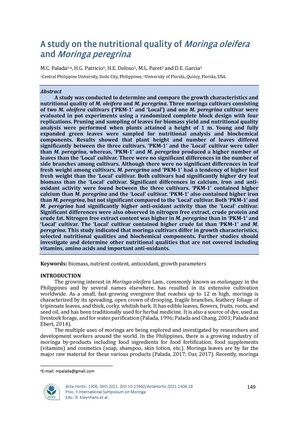Ipakita ang simpleng tala ng item
Moringa - a vegetable tree for improved nutrition, health and income of smallholder farmers
| dc.contributor.author | Ebert, Andreas | |
| dc.contributor.author | Palada, Manuel C. | |
| dc.date.accessioned | 2022-07-05T01:37:40Z | |
| dc.date.available | 2022-07-05T01:37:40Z | |
| dc.date.issued | 2017-05-09 | |
| dc.identifier.citation | Ebert, A. W. and Palada, M. C. (2017). Moringa - a vegetable tree for improved nutrition, health and income of smallholder farmers. In In Ebert, A. W. and Palada, M.C. (Eds.), I International Symposium on Moringa (pp. 309-315). International Society for Horticultural Science. https://doi.org/10.17660/ActaHortic.2017.1158.35 | en_US |
| dc.identifier.isbn | 978-94-62611-55-9 | |
| dc.identifier.issn | 0567-7572 | |
| dc.identifier.uri | https://hdl.handle.net/20.500.12852/2130 | |
| dc.description | Conference paper | en_US |
| dc.description.abstract | Moringa (Moringa oleifera) is a perennial softwood vegetable tree widely grown in the tropics of Asia, Latin America, and sub-Saharan Africa. Most parts of the tree are edible. The leaves and flowers are eaten as salad, as cooked vegetables, added to soups and sauces, or used to make tea. The young, tender pods - known as drumsticks - are highly valued as a vegetable in Asia. Moringa is nutrient-dense and rich in essential micronutrients and vitamins as well as antioxidants and bioavailable iron. According to data available at AVRDC's Nutrition Lab, moringa exceeds the micronutrient content of tomato, based on 100 g FW, by a factor of 9 to 38: β-carotene content - 15.28 mg (×38); vitamin C - 459 mg (×24); vitamin E - 25.25 mg (×22); iron - 10.09 mg (×19); folates - 93 µg (×19); antioxidant activity - 2858 TE (×9). Moringa is also rich in protein: 100 g of fresh moringa leaves contain 9.4 g of protein comprising all essential amino acids in nutritionally balanced proportions. Boiling fresh moringa leaves and dried powder in water enhances aqueous antioxidant activity and increases bioavailable iron by a factor of 3. Dried leaf powder is processed into moringa capsules and used as a dietary supplement. Depending on the genotype, leaf fresh weight of the first two harvests ranges from 560 g to 2.3 kg plant-1. Total fresh matter yield at first harvest (leaves and young shoots) depends on plant density and varies from 19.6 to 78 t ha-1 with a plant density of 95,000 and 1 million plants, respectively. Moringa has great potential to generate income for smallholder farmers and to enhance environmental services by controlling soil and wind erosion, and by providing shade and clean water. Given its multiple uses and wide range of adaptability, moringa is an ideal crop for sustainable food production. | en_US |
| dc.language.iso | en | en_US |
| dc.publisher | International Society for Horticultural Science | en_US |
| dc.relation.ispartofseries | ISHS Acta Horticulturae;1158 | |
| dc.subject.lcsh | Moringa oleifera | en_US |
| dc.subject.lcsh | Moringa | en_US |
| dc.subject.lcsh | Farmers | en_US |
| dc.subject.lcsh | Nutrition | en_US |
| dc.subject.lcsh | Medicinal plants | en_US |
| dc.title | Moringa - a vegetable tree for improved nutrition, health and income of smallholder farmers | en_US |
| dc.type | Conference paper | en_US |
| dcterms.accessRights | Limited public access | en_US |
| dc.citation.firstpage | 309 | en_US |
| dc.citation.lastpage | 315 | en_US |
| local.subject | Nutritional composition | en_US |
| local.subject | Fresh matter yield | en_US |
| local.subject | Environmental services | en_US |
| local.subject | Income generation | en_US |
| local.subject | Medicinal uses | en_US |
| local.subject | Horticultural and industrial uses | en_US |
| local.subject.scientificname | Moringa oleifera | en_US |
| local.subject.scientificname | Moringa | en_US |
| dc.identifier.doi | 10.17660/ActaHortic.2017.1158.35 | |
| dc.citation.conferencetitle | I International Symposium on Moringa | en_US |
| dc.identifier.essn | 2406-6168 |
Mga file sa item na ito
| Mga file | Sukat | Format | Tingnan |
|---|---|---|---|
|
Walang mga file na nauugnay sa item na ito. |
|||
Lumilitaw ang item na ito sa mga sumusunod na (mga) Koleksyon
-
Conference papers [17]




